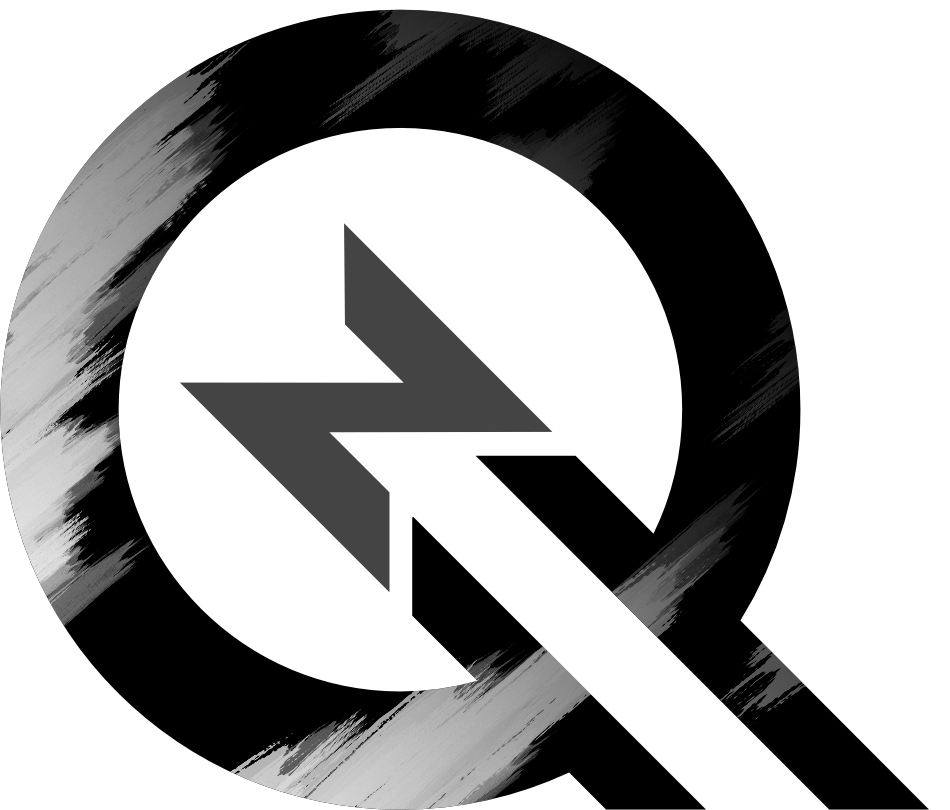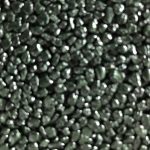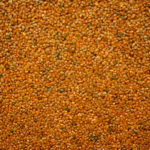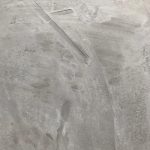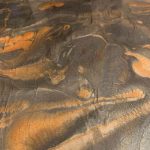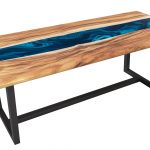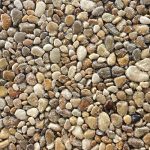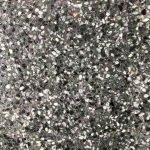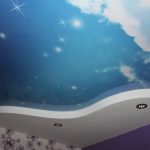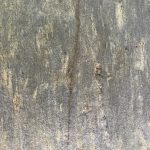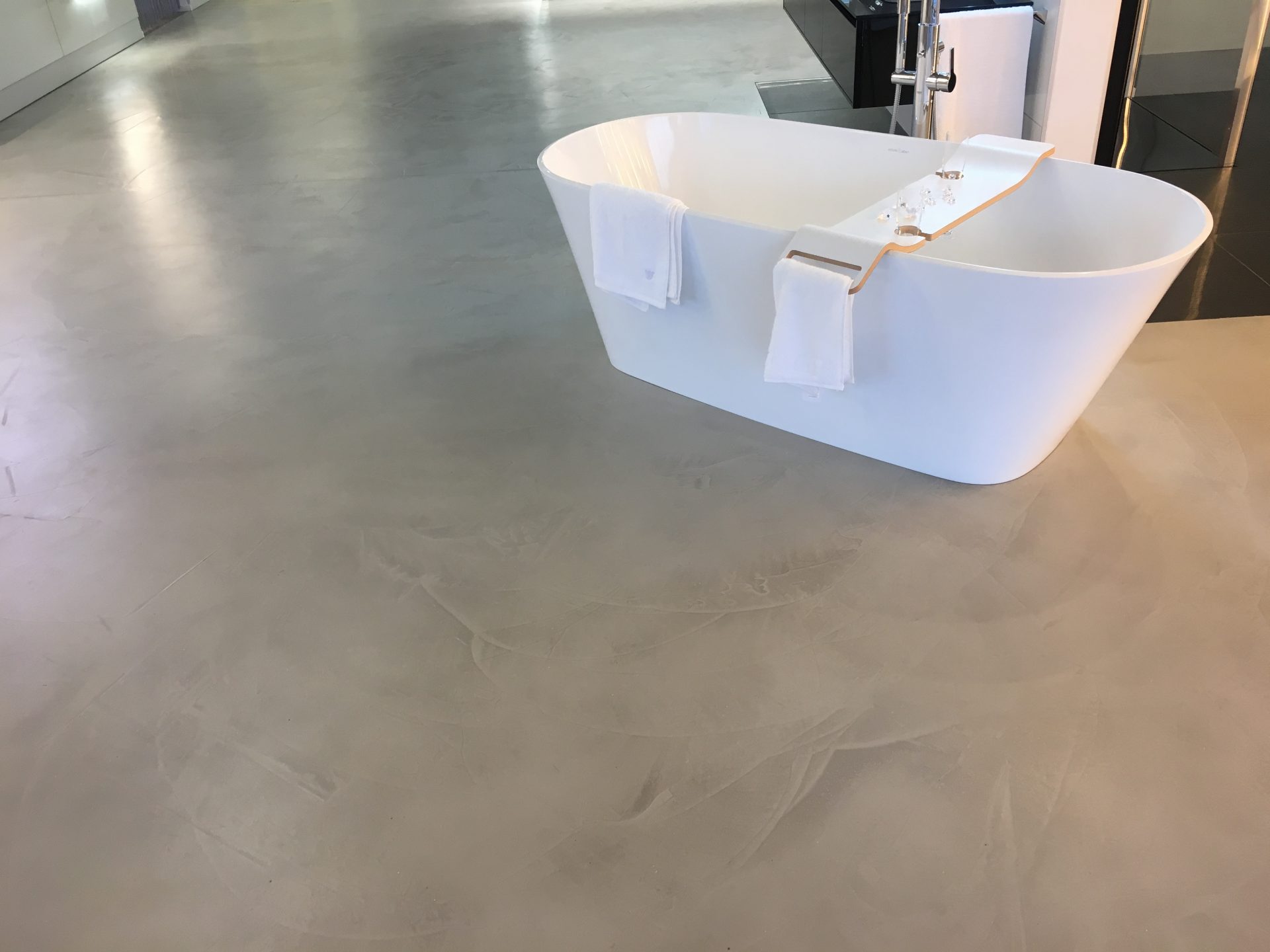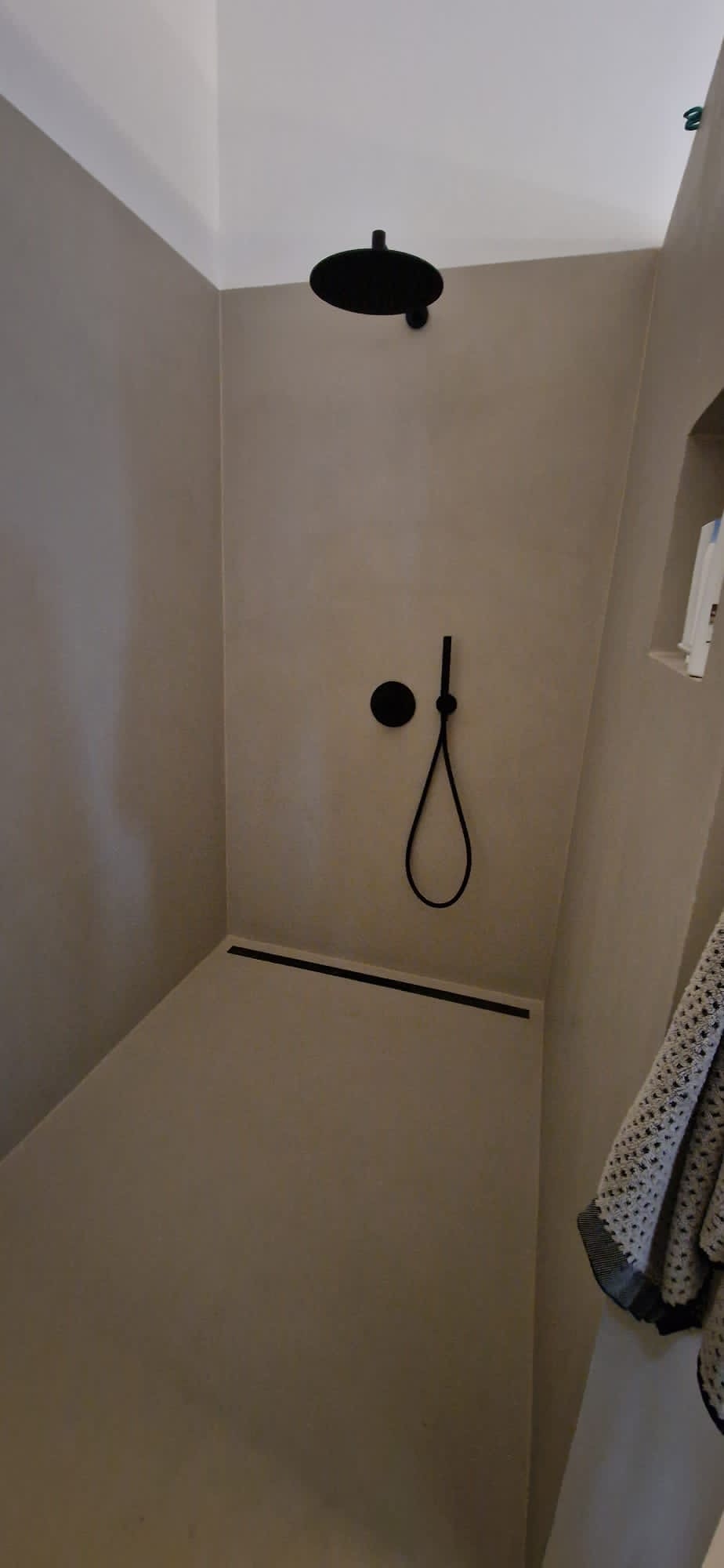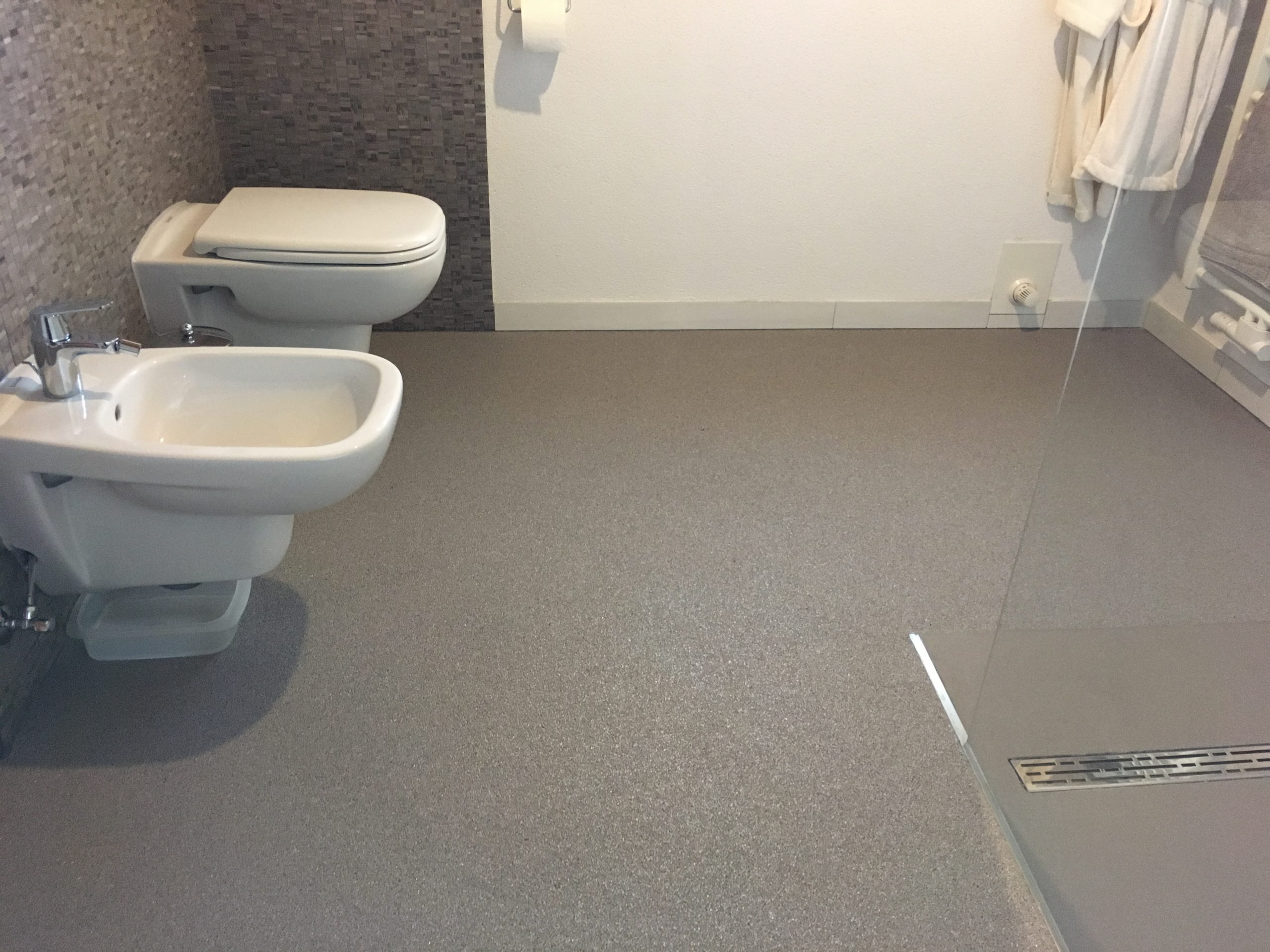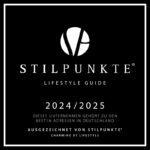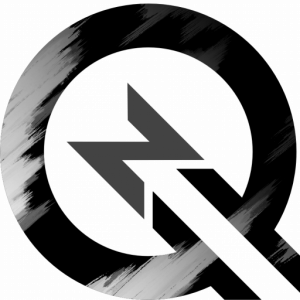Our natural quartz for creating stone carpets is dyed with various color pigments and coated with high-quality synthetic resins – based on epoxy resin or polyurethane resin, depending on the area of application. There are several hundred solid colors to choose from for the production of a quartz floor, which can also be mixed with each other. Various grain sizes are available for the production of colored quartz coatings.
Contents
- Seamless coating made of colored quartz
- Advantages of quartz gravel flooring
- Colored quartz for outdoor use
- Areas of application for quartz floors
- What is a quartz floor made of?
- In which colors is Colorquarz available?
- Qubo® Painting
- In which grain sizes is colored quartz available?
- Binder for quartz floors
- How is the Qubo® quartz floor processed?
- Non-binding Cost estimate
- Link collection
- FAQ
- Shop
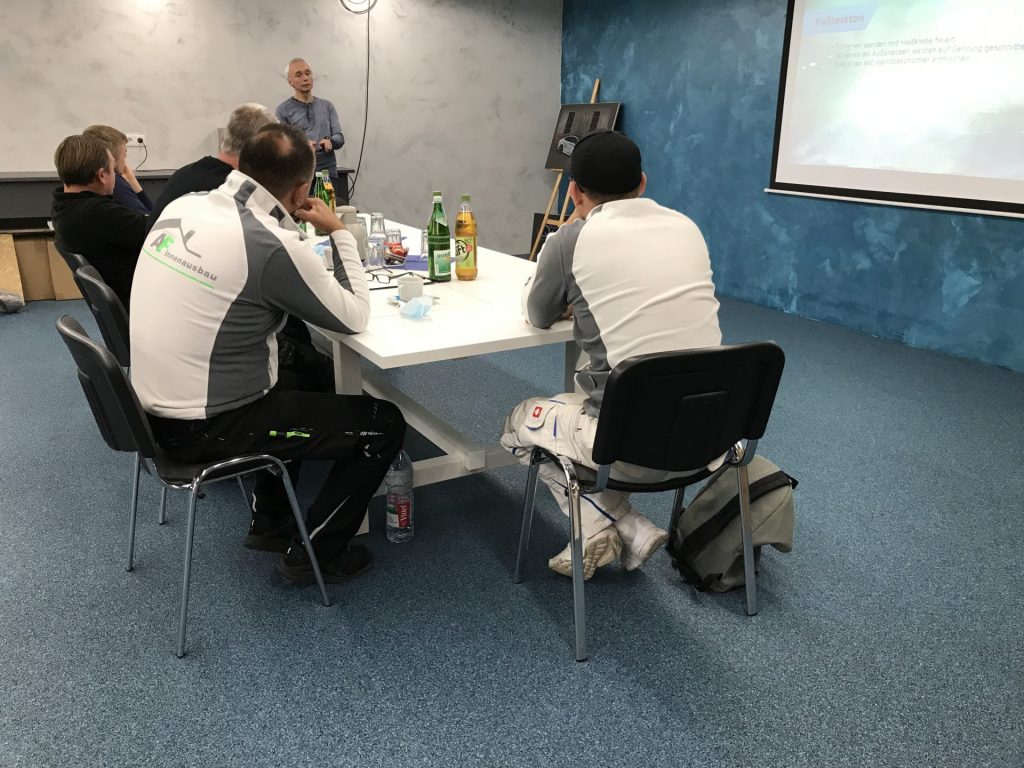
Stone carpets made of Colorkies for indoor and outdoor use Seamless floor coating made of colored quartz
The epoxy resin-bonded Qubo® quartz gravel floor is certified and tested in accordance with AgBB. It is approved for all living and recreation rooms. Colorkies is also regularly used in garages, carports, workshops and industrial halls. In light-flooded rooms and outdoors, such as on balconies and terraces, Qubo® Colorquartz is bound and laid with a UV-stable polyurethane resin.
Advantages of quartz gravel flooring
The ideal floor for allergy sufferers
A quartz floor is not only characterized by a high level of walking comfort, it is also ideal for allergy sufferers. Both properties are due to the surface structure in which house dust sinks instead of being bound. The dust can simply be vacuumed out of the structure. This makes quartz gravel flooring the ideal flooring for children’s rooms, guest rooms and bedrooms.
Easy cleaning and care
Of course, the quartz floor can not only be vacuumed, it can also be wet mopped. A wet vacuum cleaner is suitable for basic cleaning. In general, a quartz floor is a very low-maintenance floor covering. The use of a pore sealant and – depending on the intended use – an additional sealant ensure a particularly hygienic surface indoors.
Why colored quartz gravel can be used on outdoor surfaces without any problemsColor quartz for outdoor use
Many customers ask whether the wide range of gravel colors can also be used to design outdoor surfaces. The simple answer is: Yes! Special binders are used in outdoor areas to protect the quartz flooring from yellowing and fading (more on this in the section Binders). In addition, the quartz gravel itself is provided with its own PU layer for outdoor use. This encloses the already colored pebbles and protects the colors in addition to the binder. This means that Colorquarz can also be used without restriction on terraces, in gardens, in entrances and on balconies.
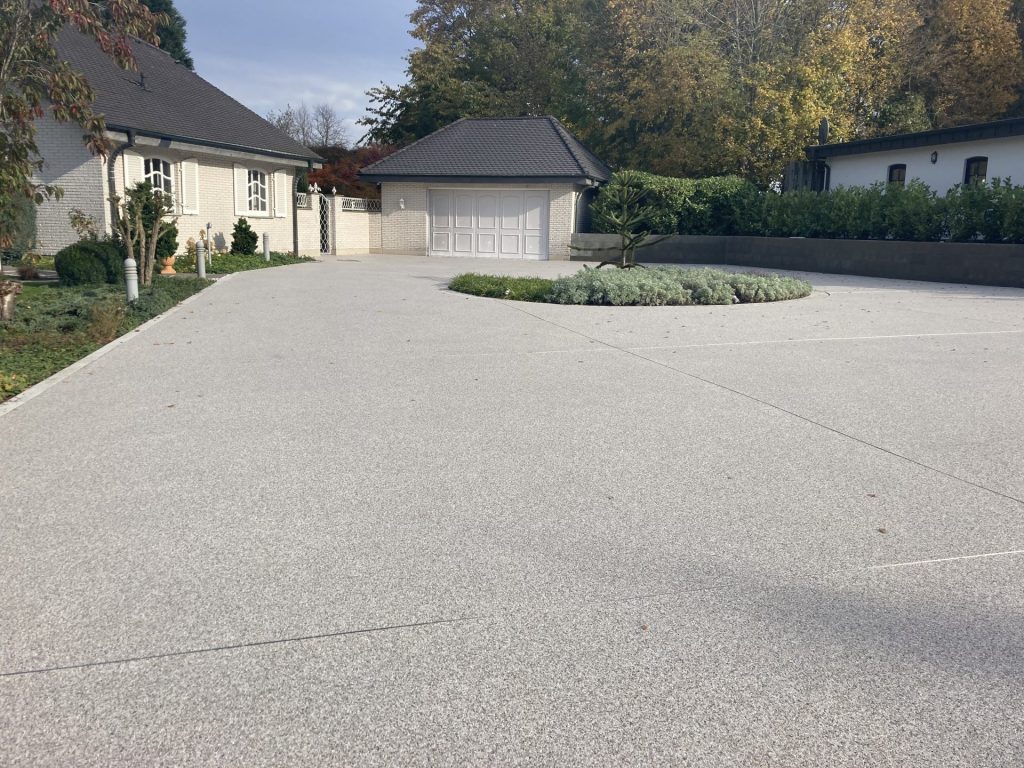
Colorquartz can be used in these places Applications for quartz floors
As a quartz gravel floor can be used indoors and as an outdoor coating, there is an enormous range of applications. Quartz floors are very popular for outdoor use on patios and balconies. There are many reasons for this. The gravel structure prevents the formation of puddles and the growth of moss.
Other possibilities in outdoor areas are as a coating for house entrances, as pool surrounds and in the pool itself. Colorquartz is also popular in outdoor catering for its variety of colors, slip resistance and stability. Since floors made of colored quartz are UV-stable, frost-proof and water-permeable in outdoor areas, a quartz floor shows its best side all year round.
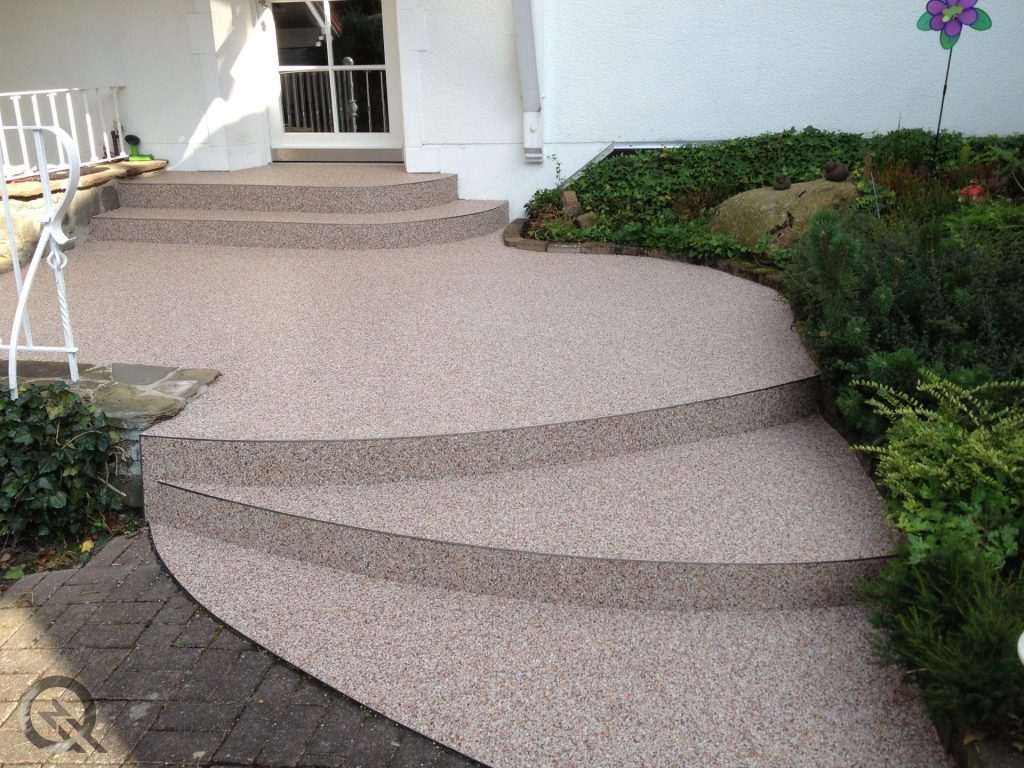
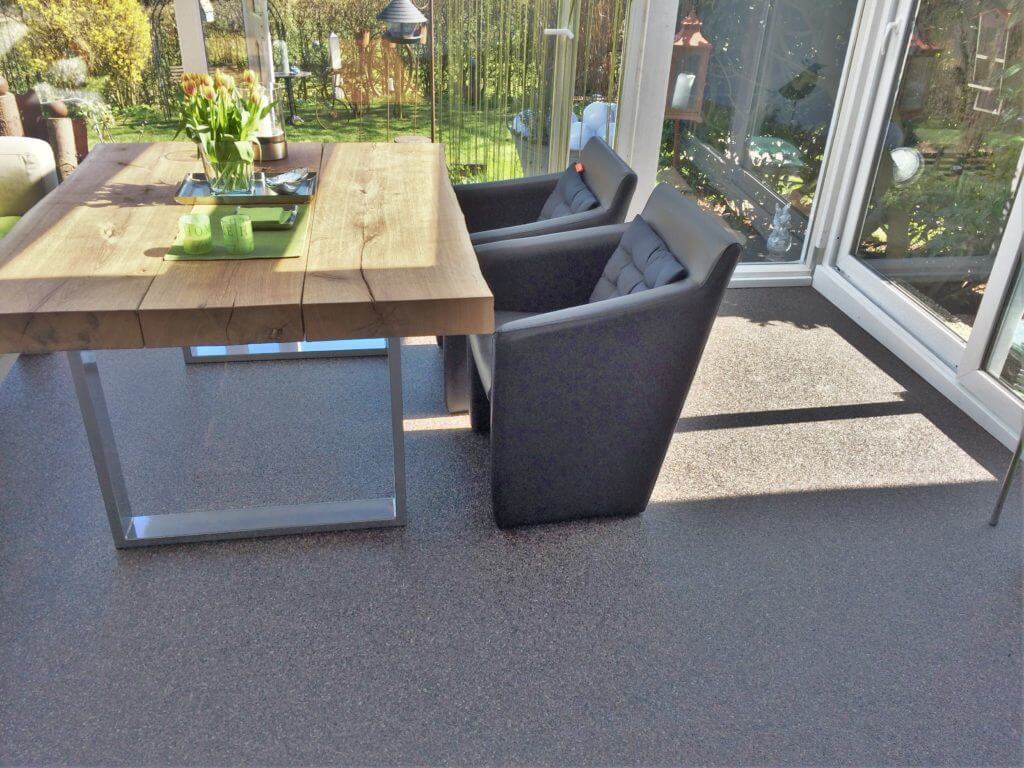
Indoors, quartz flooring is ideal for all living spaces. In living rooms, offices, party basements and conservatories, colored quartz allows for the individual design of floors, skirting boards and walls. Especially in bedrooms – including guest rooms and children’s rooms – quartz flooring with its stone structure is ideal for house dust allergy sufferers.
Stairs can be easily integrated into the design concept of the home with a quartz gravel coating.
The textured surface of the quartz flooring is ideal for pets as it prevents them from slipping on the floor. At the same time, the quartz gravel is so robust that the claws of dogs and cats do not leave any scratches.
In kitchens, bathrooms and in fitness and wellness areas, quartz floors with a porous seal are extremely easy to clean and insensitive to water, so spilled drinking glasses and moisture near the washbasin are not a problem.
Rain-soaked vehicles can be parked without hesitation in a garage with quartz flooring. Of course, commercial kitchens, the catering industry and food production companies such as butchers also benefit from the use of a quartz floor with a porous seal.
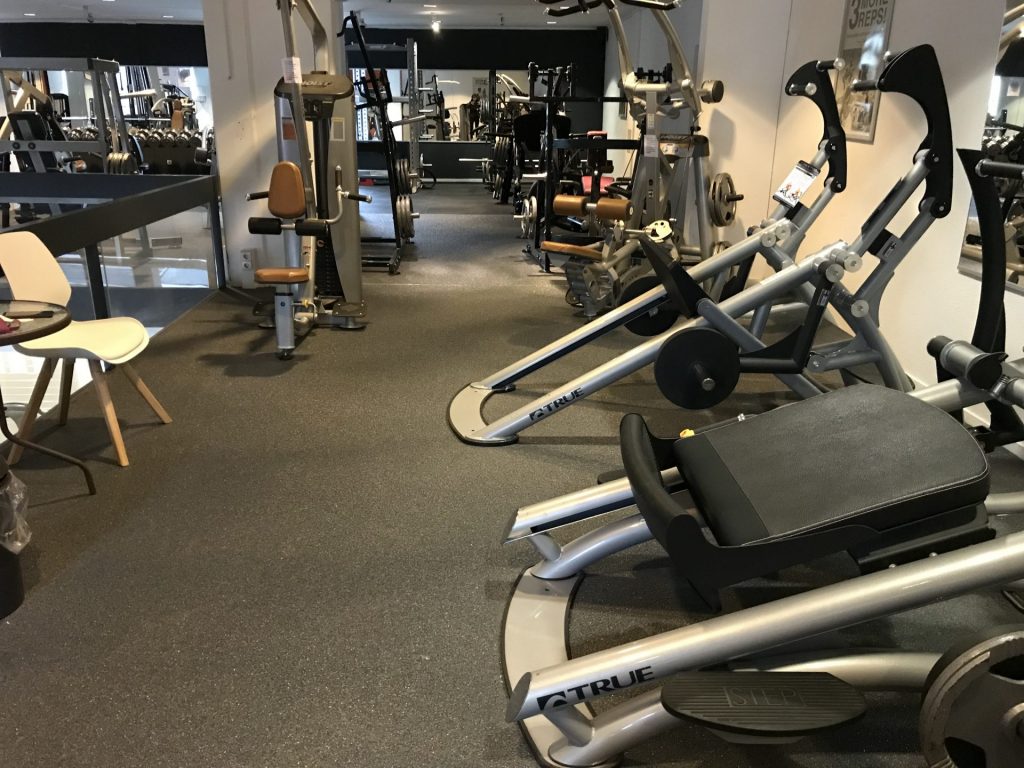
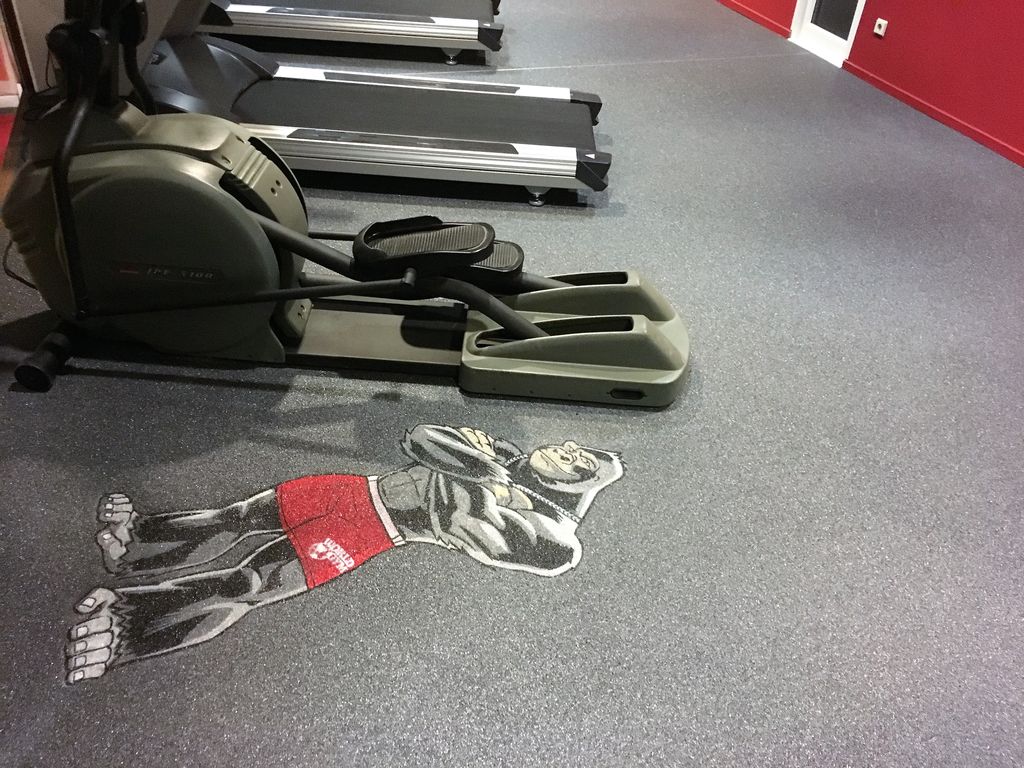
In general, Colorquarz offers the ideal opportunity to visually adapt stores such as bakeries, opticians, pharmacies and doctors’ surgeries to the corporate design in a commercial environment. Qubo® Painting motifs and logos attract attention in tattoo studios, massage practices and discotheques, but also in car dealerships and garages as soon as you enter. This way, customers will remember your store.
The many colors and different types of dyeing allow the detailed design of different business areas and exhibition spaces as well as the demarcation of walkways and seating areas in restaurants and pubs.
The enormous durability of the quartz floor, even when subjected to heavy use by a high volume of customers, makes it a worthwhile investment.
The many possible areas of application for quartz flooring can hardly be described in a single article. Many more ideas can be found in the corresponding chapter of our article Stone carpet for indoor use and our
references. An extensive collection of applications for Qubo® Painting can be found in the article of our interesting
Stone carpet logo for ordering and laying at sz art of airbrush.
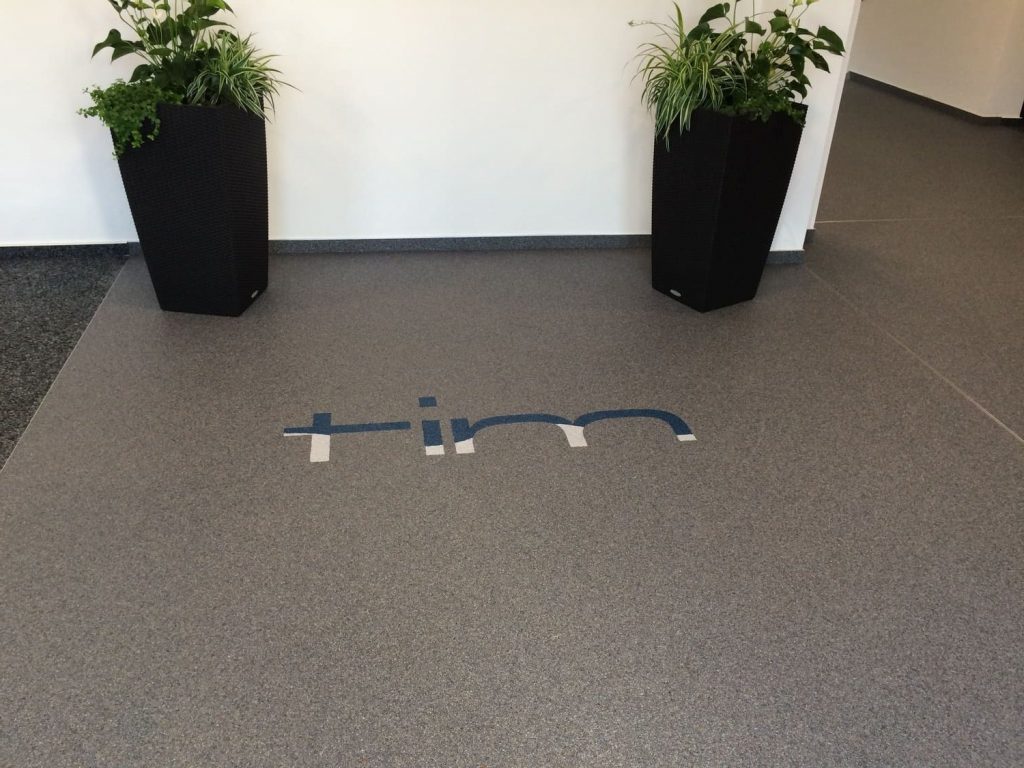
What is colored quartz and how is it prepared for flooring installation? what is a quartz floor made of?
A quartz floor consists of millions of small pebbles that are carefully selected, sieved, washed and fire-dried. They are therefore clean and dust-free.
The gravel is colored at high temperature and coated with a specially developed coating for flooring. This special process ensures color and wear resistance. As a result, the gravel colors remain permanently attractive.
From natural to metallic - these color quartz shades are available In which colors is color quartz available?
Qubo® quartz gravel is available in many hundreds of different colors. The colors are divided into different groups. Each of these groups is characterized by special optical properties.
Natural quartz
On the one hand, there is natural quartz, which, as the name suggests, occurs uncolored in completely natural stone colors. The gravel grain size makes a clear difference to the visual impression here: gravel in the typical grain size of 2-3 mm usually contains a lot of beige and white with some darker pebbles. Finer gravel is visually more reminiscent of sand.
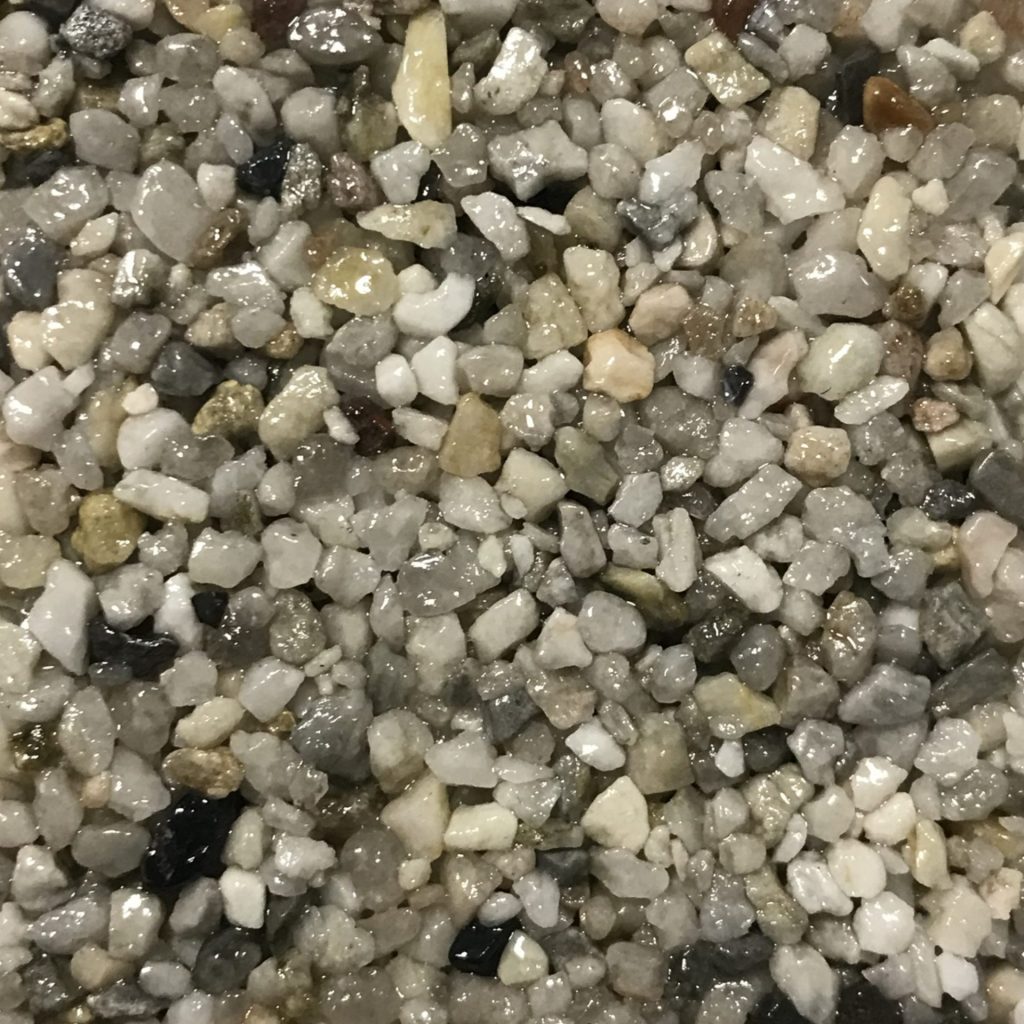
Colored quartz
In the case of colored quartz gravel – colored quartz – a distinction is made between single and multi-colored gravel as well as special coloring processes such as metallic and pearlescent.
The single-colored gravels still allow the natural differences between the quartz pebbles to shine through slightly, giving the laid floor a varied texture. Especially with softer colors, these subtle differences create a pleasant overall look.
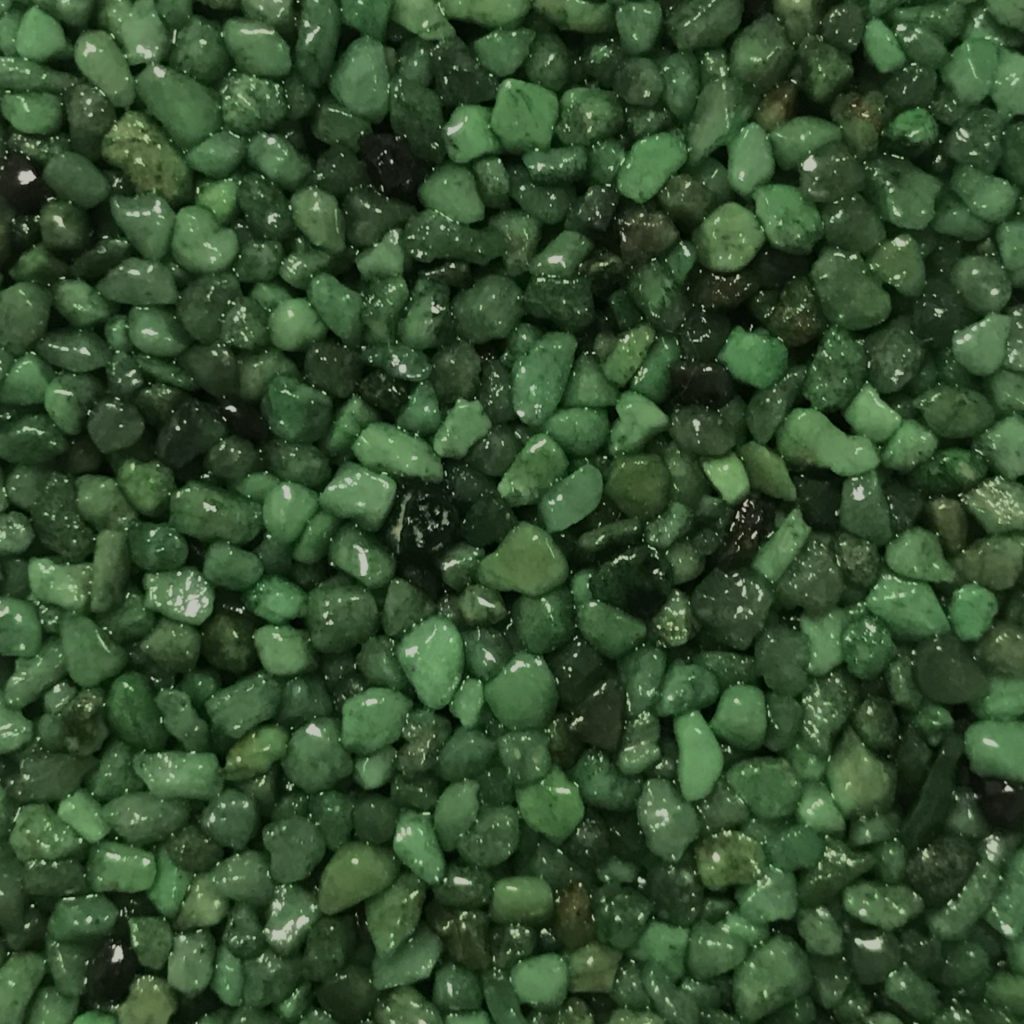
Double-colored colored quartz
Double-colored quartz pebbles are used when colors should be particularly bright and when, for example, a strong, deep black is desired. The double layer of color causes the natural differences between the pebbles to fade into the background, creating a homogeneous surface in the desired color.
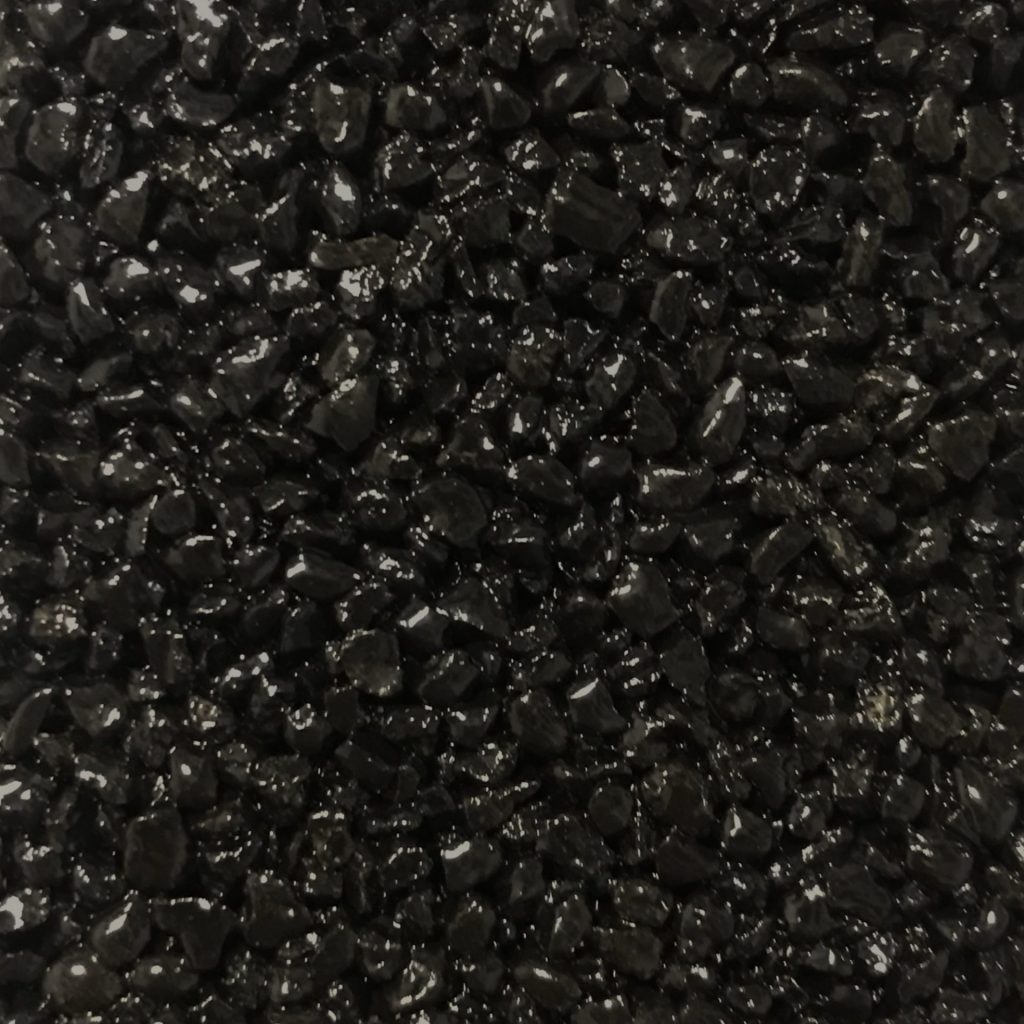
Colored quartz with metallic effect
The specially coated metallic quartz gravel is very popular in modern design environments. Strong colors with a metallic sheen allow quartz floors to shine in timeless black and silver-grey, but also in accent colors such as dark green, wine red and turquoise. This allows for interesting combinations of treads and risers in various metallic colors or skirting boards in shades that match the floor.
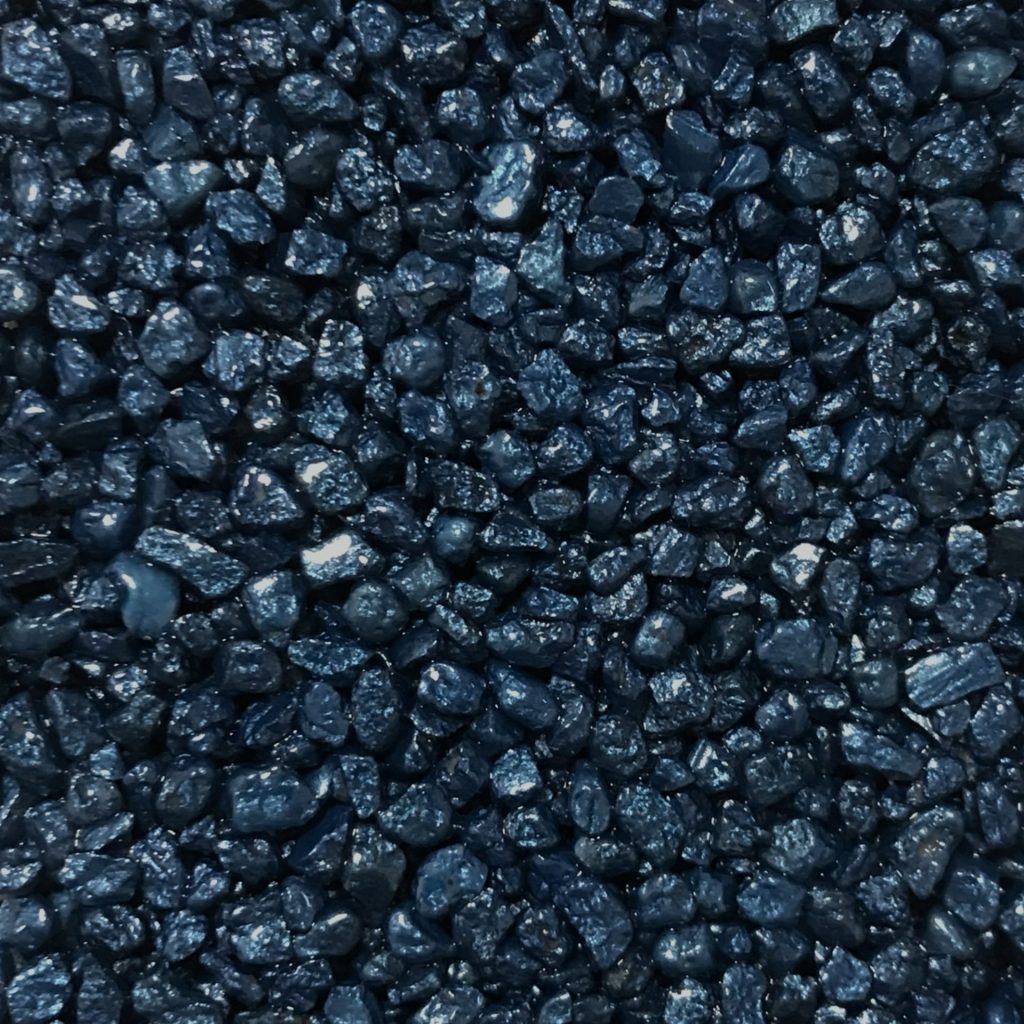
Colored quartz with pearlescent effect
Quartz pebbles in pearlescent colors are characterized by a soft, mother-of-pearl-like shimmer that gives quartz floors a sophisticated and modern look. The natural differences in the quartz pebbles are still slightly evident here and, together with the gloss effect, create an enormously interesting overall picture. Here, too, there are many different colors to choose from, from set beige and grey tones to strong light blue and grass green. This makes pearlescent quartz gravel the perfect solution for anyone for whom metallic colors are too expressive, but for whom simple gravel lacks that certain something.
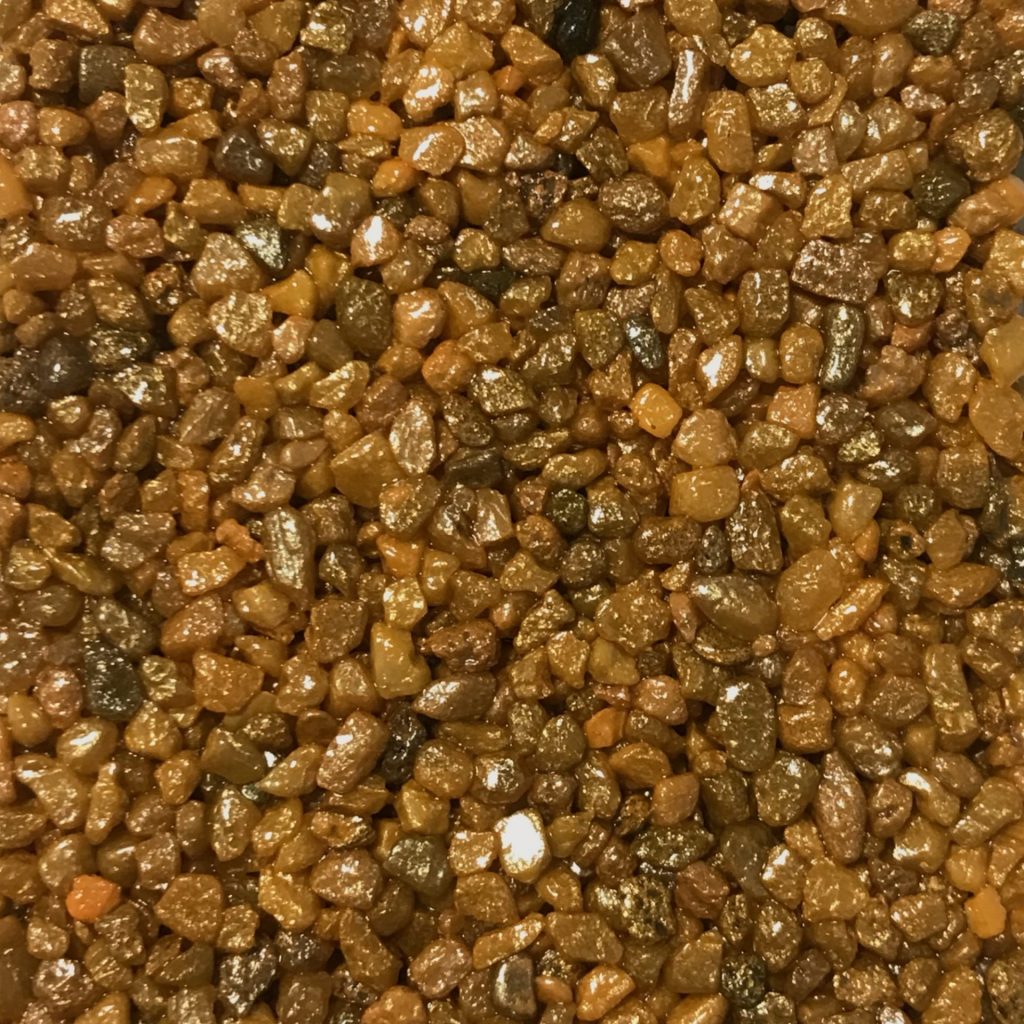
Fluorescent colored quartz
The fluorescent shades are a very special variant of quartz gravel. These specially coated granules look like typical quartz floors under normal lighting, but light up under black light. Motifs and decorative elements laid with this gravel on floors and walls are an absolute highlight in clubs, discotheques or party rooms.
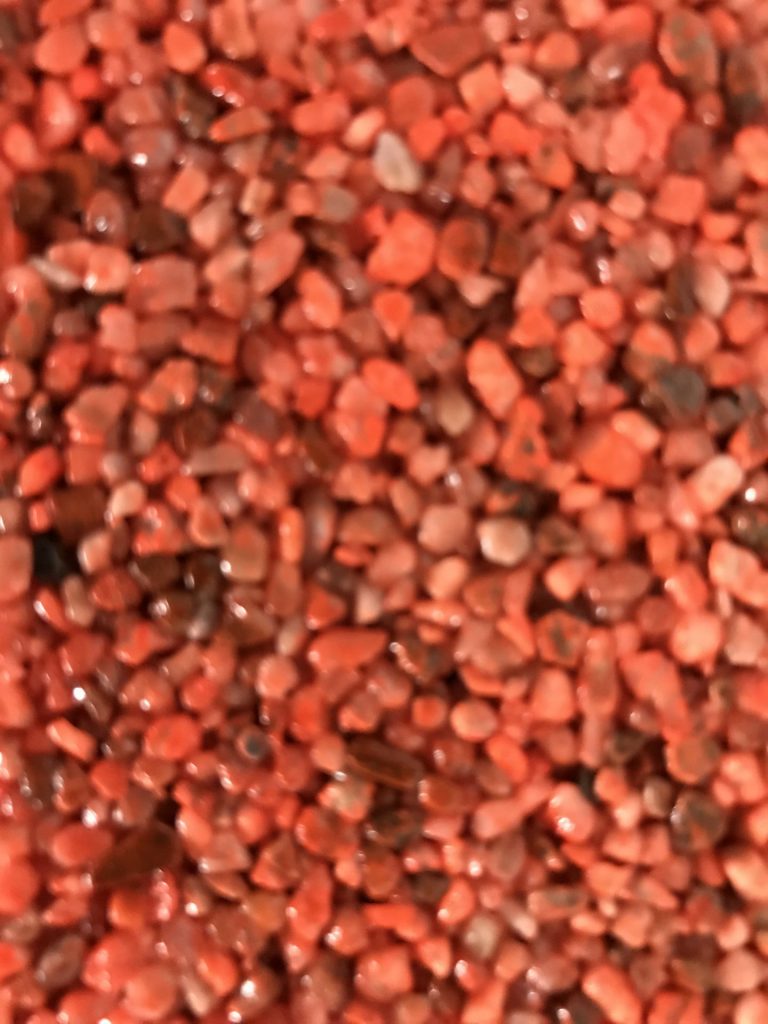
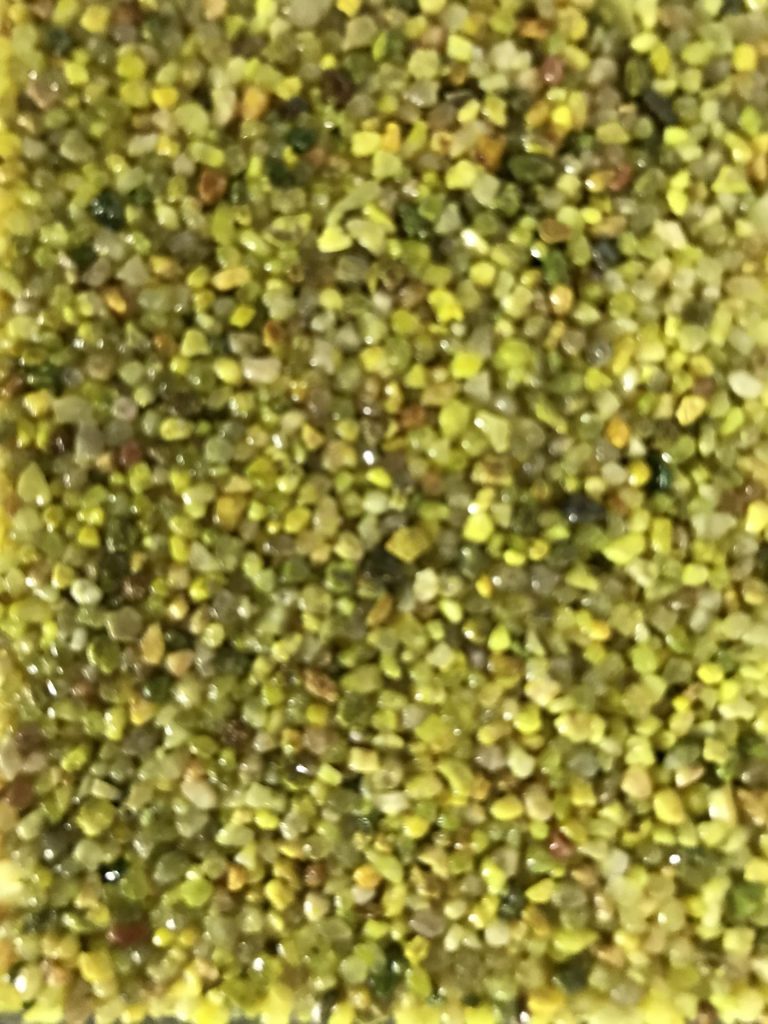
Customized logos and motifs on quartz gravelQubo® Painting
The enormous choice of colours is by no means the only way to individualize the quartz floor. The design options are even more extensive with the use of Qubo® Painting. These are airbrush works of art that are created directly on the quartz gravel and can be seamlessly integrated into the gravel floor.
The surface structure makes it possible to design motifs entirely according to your own wishes. From small, monochrome logos and lettering to large motifs with color gradients, spatial effects and plays of light and shadow, there are virtually no limits to creativity.
The works of art are created on quartz gravel in the manufactory of sz art of airbrush. The method of production is another major advantage of Qubo® Painting: instead of spraying the motifs onto the finished quartz floor on site, the work is created before construction begins. It is designed, brushed and sealed in the studio. The sealing is responsible for the high abrasion resistance of the floor motifs. The finished Qubo® Painting is then sent securely packaged to the installer or directly to the construction project, where it is laid together with the floor. This allows the quartz gravel flooring to be worked seamlessly onto the artwork.
This approach combines several advantages: customized designs without visible material transitions and without extending the construction time! For this reason, Qubo® Paintings are increasingly being used in the commercial sector. Companies benefit from the “wow” effect that company logos and lettering have on customers and visitors. As a result, business premises, products and corporate branding are generally remembered.
What are the different gravel grain sizes used for? which grain sizes are available in Colorquartz?
Colored quartz for creating stone carpets is offered in finer gradations than is the case with marble gravel, for example. The most frequently chosen variant is quartz gravel with a grain size of 2-3 millimeters. It is suitable for almost all indoor and outdoor applications and enables laying thicknesses of just 6 millimetres on indoor floors.
Depending on the intended use, it is advisable or necessary to use different grain sizes to give the quartz gravel floor certain properties. In garages, for example, color quartz with 1-2 mm and 2-3 mm are mixed together. This creates a denser stone carpet with increased stability, which can easily withstand the load of a heavily used garage.
Fine mortar gravel with a grain size of less than one millimetre is also available in many colored quartz colors and is used, for example, in industrial halls and warehouses where heavy-duty shelving is installed. The fine grain is also used to create access ramps at entrances to garages and halls.
Larger gravel sizes such as 3-4 mm or 4-6 mm are used less frequently and are particularly interesting if there is a specific reason for their use. An example of this is a balcony, where the coarse grain is mainly walked on barefoot and thus provides a pleasant walking sensation. It is also conceivable to combine a driveway with Qubo®Tec and a patio with coarse-grained Colorquarz, so that both surfaces are given an individual color, but the similar grain size creates a uniform overall impression of the gravel coatings.
Different areas of application require different binding agents Binding agents for quartz floors
The quartz gravel already makes up over 90% of the quartz floor. It gives the flooring system its exceptional strength and attractive appearance. The remaining part is the binder, which is responsible for the lasting cohesion of the gravel structure.
A good binder is also stable and transparent for decades. It is therefore important to rely on high-quality products such as the binders from Qubo®. The right components are offered here depending on the area of application.
Epoxy resin
The standard among binders is epoxy resin, also known as EP. This two-component system is used for quartz gravel floors and for coating stairs indoors. The Qubo® EP02 epoxy resin is not only characterized by its ease of application and high transparency, it is also AgBB-certified and therefore approved for use in living spaces.
Epoxy resin is not used outdoors due to the high levels of UV radiation that affect outdoor surfaces such as terraces and balconies. While sunlight has no influence on the durability itself, epoxy resin can yellow after a few years in the sunshine. Depending on the color used, this can be unproblematic, but it can also be annoying. This is why a UV-resistant binder is used for outdoor applications: Polyurethane resin!
Polyurethane resin
Polyurethane, or PU for short, has one or two components depending on the version and is used wherever increased amounts of UV radiation affect the floor. Although window panes already filter most of the rays from daylight, the use of PU resin is still recommended in rooms flooded with light, such as conservatories. The use of polyurethane resin also applies to the entire outdoor area. With the UV-resistant Qubo® PU08, the quartz gravel floor remains attractive in the long term.
Special binders for coating vertical surfaces
The single-component Qubo® PU08 is also the basis for a wall coating that can be used to create skirting boards, risers and complete wall coatings from quartz gravel. This gives Qubo® PU-WA08 a considerable advantage over epoxy resin, where the wall coating system consists of three components. The mixing of Colorquarz and wall coating thus only involves one work step during mixing. Due to its ease of application on vertical surfaces, Qubo® PU-WA08 is used both indoors and outdoors.
How is the Qubo® quartz floor processed?
Laying quartz flooring - this is how it works
The colored gravel floor can be laid quickly and also in combination with
underfloor heating. The quartz gravel is mixed with a suitable binder and applied to the primed substrate using a trowel.
The detailed processing steps required are explained in the informative article Laying stone carpet in 6 steps.
What substrate do quartz floors need?
Quartz floors can be laid on almost any substrate, such as screed, concrete, tiles, etc. In combination with a fabric mat, quartz floors can also be laid on wooden subfloors.
How high is the build-up height for a colored quartz coating?
The thickness of the coating depends on the selected grain size of the colored quartz. With a grain size of 2-3 mm, the installation thickness is 6 mm. If a grain size of 3-4 mm is used, the thickness is 8 mm.
Are baseboards also made from colored quartz?
After the quartz floor has been laid, the skirting boards are usually also made from the same material on site. The advantage of these colored quartz skirting boards is that they are perfectly matched to the look of the floor and the wall. The result is a harmonious and appealing overall look. And that is guaranteed to …
… for a strong appearance!
Non-binding cost estimate and advice
Link collection
- Product pages
- Worth knowing
- What is screed?
- Laying stone carpet in 6 steps
- Milling underfloor heating
- Stone carpeting indoors
- Stone carpet as garage & industrial flooring
- Renovate terrace & balcony with stone carpet
- Renovating balconies with stone carpet
- Stone carpet in outdoor areas
- Stone carpet in bathroom & sauna
- Renovating and refurbishing stairs with stone carpeting
- Stone carpet: The No. 1 for dogs
- Stone carpeting in the living room, children’s room and throughout the living area
- Stone carpet logo for ordering and laying (sz art of airbrush)
- Coat of arms motif on stone carpet (sz art of airbrush)
- References from Quarzkiesboden Zimmermann
- sz art of airbrush
Qubo® quartz gravel flooring is becoming increasingly popular and demand for this product is growing, as it offers many advantages. In living areas, it has all the positive properties of an ordinary stone carpet. Qubo® quartz flooring can be laid quickly and also in combination with underfloor heating.
Screed, concrete, tiles – the Qubo® can be laid on almost any substrate. In combination with a fabric mat, quartz gravel floors can even be laid on wooden subfloors.
The installation height depends on the selected grain size. The laying thickness is 6 mm for a grain size of 2 – 4 mm and 10 mm for a grain size of 4 – 8 mm.
Our Qubo® quartz gravel floors can be walked on after 24 hours and are fully cured after 7 days.
Whether in the same color or as a contrast – the ideal skirting boards are created directly on site from quartz gravel. These ensure a uniform, elegant look and can be perfectly adapted to the architectural and stylistic requirements.
Our
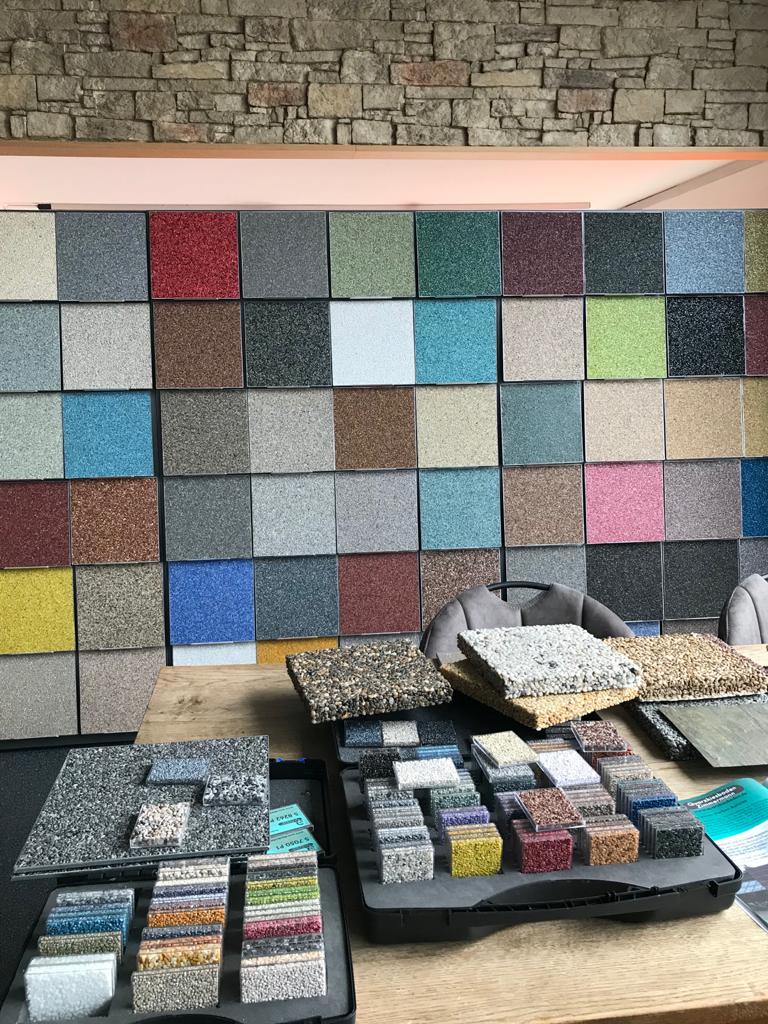
In addition to the uncolored natural quartz, quartz gravel is also available in various colors. The quartz gravel can be ordered in single-colored, double-colored or metallic versions.
Our
The textured surface also makes the floor anti-allergenic. This means that the fine house dust settles in the individual pores, is not trapped and can simply be vacuumed out. This floor is therefore predestined for house dust allergy sufferers, making it ideal for laying in bedrooms. Of course, it can also be wet mopped. A wet vacuum cleaner is suitable for basic cleaning.
The sealing with a pore seal ensures a hygienic surface. The quartz floor is also very warm underfoot. This effect is created by the insulating effect of the many small air chambers in the floor system.
Its high slip resistance is particularly beneficial for our four-legged friends. The animals feel particularly comfortable on the
Due to its sound-absorbing effect,
From the converted attic to the cellar and garage. Qubo® quartz gravel floors are all-rounders for indoor and outdoor areas, both private and commercial. Installed indoors, it is suitable for the entire living area such as the dining room, living room, conservatory, kitchen, children’s room, guest room and bedroom, utility room and office. In bathrooms and toilets, the seamless, modern surface coating replaces conventional tiles. Quartz gravel floors are also suitable for saunas, fitness and wellness areas, swimming pools and for outdoor pool surrounds.
Outdoor stairs, balconies and terraces are also covered with quartz. Due to its insensitivity to dirt, quartz flooring is often laid in entrance areas such as corridors and on stairs. A logo in the foyer is a special eye-catcher.
Thanks to its high load-bearing capacity, the quartz flooring is used in factory buildings, industrial halls and warehouses that are accessed by forklift trucks and equipped with heavy-duty shelving. Thanks to its special structure and sealing,
A separating layer can be incorporated for easy removal of the Qubo®.
For industrial purposes, a floor must remain durable and hard-wearing for decades. The surface must also be resistant to various liquids and chemicals.
Our Qubo® quartz gravel flooring meets these requirements with flying colors. We can also adapt your quartz gravel floor to your corporate design and brand it with your company logo.
All
The binders used, which consist of natural resins and a hardener component, are a very important issue when creating these top floors. The
The standard gravel grain sizes are 1 – 2 mm, 2 – 3 mm and 3 – 4 mm.
Depending on the design of the staircase, the renovation takes 3-5 days.
Due to its structure and thin layer thickness, a quartz gravel floor is ideal for underfloor heating.
The quartz gravel layer, which is only a few millimetres thick, heats up faster than a much thicker tiled floor, for example. At the same time, the granular structure of the quartz gravel floor provides a considerably larger surface area than smooth floor coverings. This allows the heat to be transferred to the room air more quickly.
Due to its insensitivity to dirt, it is very suitable for laying on stairs. This also applies to corridors, foyers and entrance areas.
The original slip resistance class of a quartz gravel floor is R10. With a special seal, any slip resistance class can be set.
Man kann den Quarzkiesboden einfach trocken saugen, nass wischen oder ein Nasssauggerät verwenden.
FAQ
Details and facts, key figures and explanations – here you will find answers to frequently asked questions about our Qubo® coating systems. If any details remain unclear, simply contact us. We will be happy to advise you personally and promptly.
